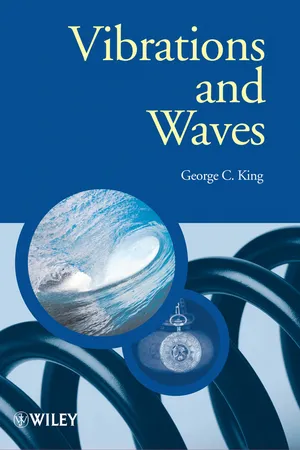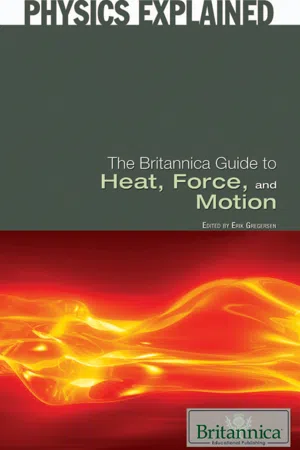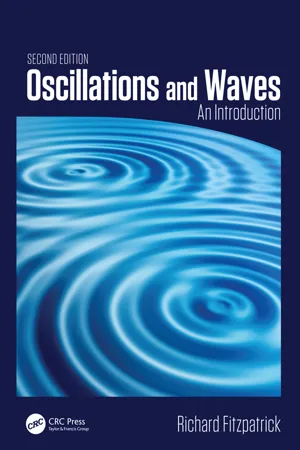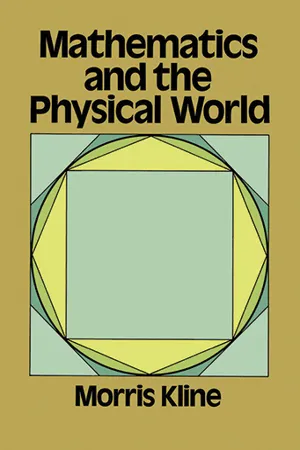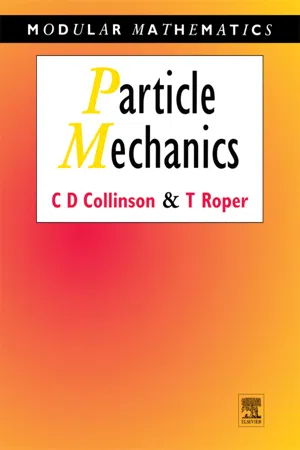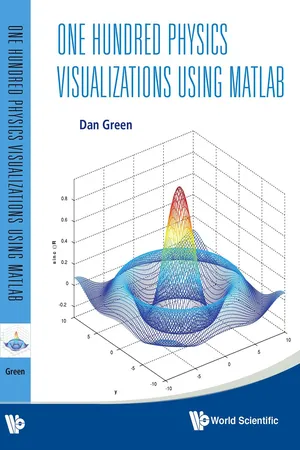Physics
Simple Pendulum
A simple pendulum is a weight suspended from a pivot point that oscillates back and forth under the influence of gravity. The motion of a simple pendulum is periodic and can be described using the principles of harmonic motion. The period of the pendulum, or the time it takes to complete one full oscillation, depends on the length of the pendulum and the acceleration due to gravity.
Written by Perlego with AI-assistance
Related key terms
Related key terms
1 of 4
Related key terms
1 of 3
11 Key excerpts on "Simple Pendulum"
- eBook - ePub
- George C. King(Author)
- 2013(Publication Date)
- Wiley(Publisher)
inertia of the mass that causes it to overshoot. The apple has kinetic energy because of its motion. We notice that its velocity is zero when its displacement from the equilibrium position is a maximum and so its kinetic energy is also zero at that point. The apple also has potential energy. When it moves away from the equilibrium position the apple’s vertical height increases and it gains potential energy. When the apple passes through the equilibrium position its vertical displacement is zero and so all of its energy must be kinetic. Thus at the point of zero displacement the velocity has its maximum value. As the apple swings back and forth there is a continuous exchange between its potential and kinetic energies. These characteristics of the pendulum are common to all simple harmonic oscillators: (i) periodic motion; (ii) an equilibrium position; (iii) a restoring force that is directed towards this equilibrium position; (iv) inertia causing overshoot; and (v) a continuous flow of energy between potential and kinetic. Of course the oscillation of the apple steadily dies away due to the effects of dissipative forces such as air resistance, but we will delay the discussion of these effects until Chapter 2.1.2 A MASS ON A SPRING
1.2.1 A mass on a horizontal spring
Our first example of a simple harmonic oscillator is a mass on a horizontal spring as shown in Figure 1.1 . The mass is attached to one end of the spring while the other end is held fixed. The equilibrium position corresponds to the unstretched length of the spring and x is the displacement of the mass from the equilibrium position along the x - eBook - ePub
Elementary Differential Equations
Applications, Models, and Computing
- Charles Roberts(Author)
- 2018(Publication Date)
- Chapman and Hall/CRC(Publisher)
10.7. PendulumsIn this section, we will determine critical points for several kinds of pendulums and pendulum systems and study their behavior by examining phase-plane graphs. Since electrical and other mechanical systems give rise to similar systems of differential equations, the results which we obtain here for pendulums will apply to those electrical and mechanical systems also.Simple PendulumA Simple Pendulum consists of a rigid, straight rod of negligible mass and length ℓ with a bob of mass m attached at one end. The other end of the rod is attached to a fixed support, S , so that the pendulum is free to move in a vertical plane. Let y denote the angle (in radians) which the rod makes with the vertical extending downward from S —an equilibrium position of the system. We arbitrarily choose y to be positive if the rod is to the right of the downward vertical and negative if the rod is to the left of the downward vertical as shown in Figure 10.21.Figure 10.21. Simple Pendulum.We will assume the only forces acting on the pendulum are the force of gravity, a force due to air resistance which is proportional to the angular velocity of the bob, and an external force, f (t ), acting on the pendulum system. Under these assumptions it can be shown by applying Newton’s second law of motion that the position of the pendulum satisfies the initial value problem(1)my ″+ cy ′+ k sin y = f( t ); y( 0 )=c 0,y ′( 0 )=c 1whereLinearized Simple Pendulum with No Damping and No Forcing Functionc ≥ 0is a constant of proportionality,k = m g / ℓ, g is the constant of acceleration due to gravity,c 0is the initial angular displacement of the pendulum from the downward vertical, andc 1is the initial angular velocity of the pendulum.If we assume there is no damping (c = 0) and no forcing function (f ( t ) = 0 - eBook - ePub
- H. John Pain(Author)
- 2013(Publication Date)
- Wiley(Publisher)
1
Simple Harmonic Motion
At first sight the eight physical systems in Figure 1.1 appear to have little in common.1.1(a) is a Simple Pendulum, a mass m swinging at the end of a light rigid rod of length l . 1.1(b) is a flat disc supported by a rigid wire through its centre and oscillating through small angles in the plane of its circumference. 1.1(c) is a mass fixed to a wall via a spring of stiffness s sliding to and fro in the x direction on a frictionless plane. 1.1(d) is a mass m at the centre of a light string of length 2l fixed at both ends under a constant tension T . The mass vibrates in the plane of the paper. 1.1(e) is a frictionless U-tube of constant cross-sectional area containing a length l of liquid, density ρ , oscillating about its equilibrium position of equal levels in each limb. 1.1(f) is an open flask of volume V and a neck of length l and constant cross-sectional area A in which the air of density ρ vibrates as sound passes across the neck. 1.1(g) is a hydrometer, a body of mass m floating in a liquid of density ρ with a neck of constant cross-sectional area cutting the liquid surface. When depressed slightly from its equilibrium position it performs small vertical oscillations. 1.1(h) is an electrical circuit, an inductance L connected across a capacitance C carrying a charge q . All of these systems are simple harmonic oscillators which, when slightly disturbed from their equilibrium or rest postion, will oscillate with simple harmonic motion. This is the most fundamental vibration of a single particle or one-dimensional system. A small displacement x from its equilibrium position sets up a restoring force which is proportional to x acting in a direction towards the equilibrium position.Thus, this restoring force F may be writtenwhere s , the constant of proportionality, is called the stiffness and the negative sign shows that the force is acting against the direction of increasing displacement and back towards the equilibrium position. A constant value of the stiffness restricts the displacement x - eBook - ePub
- Sir James H. Jeans(Author)
- 2013(Publication Date)
- Dover Publications(Publisher)
a , provided this does not involve the string ever becoming unstretched. Find the period of the motion.THE CYCLOIDAL PENDULUM
210 . We have seen that the motion of a Simple Pendulum is simple harmonic motion only so long as the amplitude of the motion is small. It is, however, possible to constrain a particle to move under gravity in such a way that its motion shall be simple harmonic motion no matter how great the amplitude.To find the curve in which the particle must be constrained to move, let us go back to equation (94), namelywhich is the equation of motion of a particle constrained to move in any curve, provided θ is the angle which the tangent to the curve at a distance s along it makes with the horizontal. For this equation to represent simple harmonic motion, the acceleration must be equal to — k 2 s. Thus we must have(99)so that sin θ must be proportional to s.211. This relation expresses a property of the cycloid, — i.e. of the curve described in space by a point on the rim of a circle which rolls along a straight line. For, in fig. 132 , let P be a point on a cycloid which is formed by a circle rolling along the line EF. When the point on the rim of the moving circle is at P, let A be the point of the circle which is in contact with the line EF; and let AB be the diameter of the circle which passes through A.FIG. 132At the instant considered, we know that the motion of the point P on the rim of the circle is perpendicular to the line AP (see example 1 on p. 9). Thus since APB is a right angle, the motion must be along BP. Thus BP - eBook - ePub
- Britannica Educational Publishing, Erik Gregersen(Authors)
- 2010(Publication Date)
- Britannica Educational Publishing(Publisher)
A Simple Pendulum . Copyright Encyclopædia Britannica; rendering for this edition by Rosen Educational ServicesConsider a Simple Pendulum with a bob of mass M suspended by a massless cable or bar of length L from a point about which it pivots freely. The angle between the cable and the vertical is called θ . The force of gravity acting on the mass M , always equal to -Mg in the vertical direction, is a vector that may be resolved into two components, one that acts ineffectually along the cable and another, perpendicular to the cable, that tends to restore the bob to its equilibrium position directly below the point of suspension. This latter component is given byThe bob is constrained by the cable to swing through an arc that is actually a segment of a circle of radius L . If the cable is displaced through an angle θ , the bob moves a distance Lθ along its arc (θ must be expressed in radians for this form to be correct). Thus, Newton’s second law may be writtenEquating equation (22) to equation (23), one sees immediately that the mass M will drop out of the resulting equation. The Simple Pendulum is an example of a falling body, and its dynamics do not depend on its mass for exactly the same reason that the acceleration of a falling body does not depend on its mass: both the force of gravity and the inertia of the body are proportional to the same mass, and the effects cancel one another. The equation that results (after extracting the constant L from the derivative and dividing both sides by L ) isA segment of a circle of radius L. Copyright Encyclopædia Britannica; rendering for this edition by Rosen Educational ServicesIf the angle θ is sufficiently small, equation (24) may be rewritten in a form that is both more familiar and more amenable to solution. Consider a segment of a circle of radius L . A radius vector at angle θ locates a point on the circle displaced a distance Lθ along the arc. It is clear from the geometry that L sin θ and Lθ are very nearly equal for small θ . It follows then that sin θ and θ are also very nearly equal for small θ . Thus, if the analysis is restricted to small angles, then sin θ may be replaced by θ - eBook - ePub
Oscillations and Waves
An Introduction, Second Edition
- Richard Fitzpatrick(Author)
- 2018(Publication Date)
- CRC Press(Publisher)
τ is the torque. Using similar arguments to those employed for the case of the Simple Pendulum (recalling that the weight of the pendulum acts at its center of mass), we can writeτ = − M g d sin θ .(1.56)The reaction, R, at the peg does not contribute to the torque, because its line of action passes through the pivot. Combining the previous two equations, we obtain the following angular equation of motion of the pendulum,I = − M g d sin θ .(1.57)Finally, adopting the small-angle approximation, sin θ ≃ θ, we arrive at the simple harmonic oscillator equation,By analogy with our previous solutions of such equations, the angular frequency of small amplitude oscillations of a compound pendulum is given byI(1.58)θ ¨≃ − M g d θ .ω =(1.59).M g dIIt is helpful to define the so-called effective length of the pendulum,L =(1.60)I.M dEquation (1.59) reduces toω =(1.61)g L,which is identical in form to the corresponding expression for a Simple Pendulum. (See Section 1.5 .) We conclude that a compound pendulum behaves like a Simple Pendulum whose length is equal to the effective length.EXERCISES
1.1 A mass stands on a platform that executes simple harmonic oscillation in a vertical direction at a frequency of 5 Hz. Show that the mass loses contact with the platform when the displacement exceeds 10−2 m. [From Pain 1999.]1.2 A small body rests on a horizontal diaphragm of a loudspeaker that is supplied with an alternating current of constant amplitude but variable frequency. If the diaphragm executes simple harmonic oscillation in the vertical direction of amplitude 10 µm, at all frequencies, find the greatest frequency (in hertz) for which the small body stays in contact with the diaphragm.1.3 A mass m is attached to the mid-point of a stretched string of negligible mass, length 2l, and uniform tension T. Let x ≪ l be the transverse displacement of the mass from its equilibrium position. Show that the displacement executes simple harmonic oscillation at the angular frequencyω =2 T / l m - eBook - ePub
- William Bolton(Author)
- 2012(Publication Date)
- Routledge(Publisher)
natural frequency, such frequencies being determined by the properties of the system.3 Forced oscillations Oscillations which take place under the effect of externally applied periodic forces are called forced oscillations. Thus if the support of the spring system in Figure 6.1(a) was itself oscillating it would give forced oscillations of the spring system.4 Damping Oscillating mechanical systems are all subject to damping due to energy being dissipated by friction and other resistances. With free oscillations, since no energy is externally supplied to the system when oscillating then the effect of energy being dissipated by damping is for the oscillations to die away with time. Thus if the Simple Pendulum in Figure 6.1(c) is set into free oscillation, the oscillation will gradually die away with time with the amplitude of the oscillation becoming progressively smaller.6.2 Simple harmonic motionThe simplest form of periodic motion is simple harmonic motion. Consider a basic mechanical system of mass which when deflected from its rest position is restored to it by forces arising from elasticity in the system. Figure 5.3 shows such a system as a trolley tethered between two supports by springs. A trolley is considered for the mass in order to effectively eliminate frictional effects.Figure 6.3 A basic mechanical systemWhen the trolley, the mass of the system, is pulled to one side then one of the springs is compressed and the other stretched and this has the effect of providing a restoring force which is directed in such a direction as to endeavour to restore the trolley back to its original position. If the trolley is released from this deflected position, the restoring force causes the trolley to move back towards its original rest position and overshoot that position. The restoring force then reverses its direction to still be directed towards the rest position and so oscillations occur. If the displacement from the rest position is measured as a function of time then the result is as shown in Figure 6.4 - eBook - ePub
- Morris Kline(Author)
- 2012(Publication Date)
- Dover Publications(Publisher)
Historically, the investigation of oscillatory motions was motivated by the desire to improve methods of telling time. The primary standard of time is, of course, the motion of the earth around the sun, but this natural clock is not particularly useful in the daily affairs of man. In the seventeenth century the need to measure small periods of time accurately for the purpose of telling longitude at sea caused scientists to search for increasingly accurate clocks. The search resulted in some major successes that were at least as valuable for the advancement of mathematics and the study of other phenomena of nature, such as light and sound, as they were for the specific problem of measuring time.Scientists naturally concentrated on any physical phenomena that seemed to be periodic or repetitive and might therefore be related to the periodic motion of the planets. Two phenomena recommended themselves for closer investigation, the motion of an object or bob, as it is called, on a spring, and the motion of a pendulum. The first of these attracted the attention of Robert Hooke (1635—1703), a contemporary of Newton, a professor of mathematics and mechanics at Gresham College in England, and a noted experimentalist.Let us consider with Hooke the motion of a bob on a spring. The bob is attached to the lower end of the spring (fig. 93 ) whose upper end is attached to a fixed support. Gravity will pull the bob down until the tension in the spring offsets the force of gravity. Unless disturbed the bob will then remain in a fixed position, which is called its rest or equilibrium position. Since we intend to disturb the bob and set it in motion let us agree to introduce a variable y that will represent its displacement from the rest position. When the displacement is upward we shall consider y to be positive and when downward, negative. Also, we shall ignore the resistance of air. While this resistance does dampen the motion its effect is secondary.Fig. 93 - eBook - ePub
- Chris Collinson, Tom Roper(Authors)
- 1995(Publication Date)
- Butterworth-Heinemann(Publisher)
In theory you should be able to balance a flat headed screw, or nail, upright on its point. The screw would be in a position of equilibrium. In practice you will inevitably fail to do so because this position of equilibrium is unstable and so if you release the screw at even the smallest of angles to the vertical it will move right away from the position of equilibrium and fall down. The task is far easier if you try to balance the screw on its flat end. This corresponds to a position of stable equilibrium. You will probably notice that when you release the screw it wobbles slightly but then settles down in an upright position. Of course if you are really clumsy the screw will again fall down but that is because you are not releasing it close enough to its position of equilibrium. Most of the objects about us are in equilibrium, usually in stable equilibrium. Two particular examples which can usefully be adapted to both thought and actual experimentation are bodies suspended at rest at the end of inextensible strings - light pulls, chains on old toilet cisterns, pulls on roller blinds, plumblines, children’s swings - and bodies suspended at rest at the end of elastic strings or springs - simple spring scales used for weighing, exhausted bungee divers; perhaps you can add to these lists? In the first examples the body can be disturbed from its equilibrium position by moving it so that the string, although taut, is no longer vertical. When released the body will swing about its position of equilibrium. Of course this motion is not straight line motion. This suggests that the concepts of equilibrium and stability will be of importance in situations other than straight line motion. In the second examples the body can be disturbed from its equilibrium position by displacing it vertically. When released it will oscillate on a vertical line about its position of equilibrium. Neither the swinging nor the oscillation of the bodies discussed above are in any way random. Both are regular and are examples of a special motion, called simple harmonic, which characterizes the motion of any particle close to a position of stable equilibrium.TUTORIAL PROBLEM 3.2(i) Imagine a small body suspended by a spring from a fixed point. The body is pulled down and released at time t = 0 from the point x = a > 0. Here the displacement x - eBook - ePub
Experiments and Demonstrations in Physics
Bar-Ilan Physics Laboratory
- Yaakov Kraftmakher(Author)
- 2014(Publication Date)
- WSPC(Publisher)
et al (2002) observed oscillations of a pendulum with one of three damping effects: friction not depending on the velocity (sliding friction), linear dependence on the velocity (eddy currents in a metal plate), and quadratic dependence on the velocity (air friction).For other experiments with pendulums, see Lapidus (1970); Schery (1976); Hall and Shea (1977); Simon and Riesz (1979); Hall (1981); Yurke (1984); Eckstein and Fekete (1991); Ochoa and Kolp (1997); Peters (1999); Lewowski and Woźniak (2002); LoPresto and Holody (2003); Parwani (2004); Coullet et al (2005); Ng and Ang (2005); Jai and Boisgard (2007); Gintautas and Hübler (2009); Mungan and Lipscombe (2013).Theoretical background. For a mathematical pendulum with friction, the motion equation iswhere m is the mass, a is the acceleration, x is the displacement, v is the velocity, k and λ are coefficients of proportionality, x′ = v = dx/dt, and x″ = d2 x/dt2 . The solution to this equation describing free oscillations iswhere A and φ1 depend on the initial conditions. The natural frequency of the system is ω0 = (k/m)½ = (g/l)½ , the decay of free oscillations is governed by the decay constant δ = λ/2m, and the angular frequency Ω is somewhat lower than ω0 : Ω2 = ω0 2 – δ2 .The transient process after application of a periodic driving force deserves special consideration. Whenever forced oscillations start, a process occurs leading to steady oscillations. This transient process is caused by the superposition of forced and free oscillations. Landau and Lifshitz (1982) and Pippard (1989) considered the problem in detail, and this analysis is partly reproduced here. For a driven mathematical pendulum - eBook - ePub
- Dan Green(Author)
- 2013(Publication Date)
- WSPC(Publisher)
Chapter 2 Classical Mechanics “The squares of the periodic times are to each other as the cubes of the mean distances.”— Johannes Kepler“Two things that matter to me; emotional resonance and rocket launchers.”— Joss Whedon“The earth doesn’t move backward (very much) when you walk only because it’s much more massive than you are.”— K.C. ColeThe first section was devoted to the mathematical tools which are of general use in this text. Typically there was a script written with a user menu which wrapped a specific MATLAB function. Now the demonstrations for real physics problems begin. In general, the same format for the scripts is in place; an introductory printout, an example and then a user menu to enable the user to build up an intuition about the problem. The displays and plots aim to be “movies” whenever possible, to give a sense of the dynamics of the problem as it evolves in time. A “movie” of the time development allows the user to appreciate both the development of the system in position and the time dependent velocity.2.1. Simple Harmonic OscillatorGalileo began the study of physics described mathematically. The story goes that he measured the periods of chandeliers in church using his pulse to measure the time and thus found that the period depended on the length of the device. It is now accepted almost universally that the Universe can be apprehended mathematically which is a great mystery why that should be so.One of the simplest problems in mechanics is the harmonic oscillator realized as a mass, m, on a spring with spring constant k moving in one dimension, x, in time t. The spring restoring force is a representation of the situation for small oscillations of any bound system, since it represents the first term in the Taylor expansion of the force binding the particle. The one-dimensional differential equation is:where b is a damping factor and B is a harmonic driving term with driving frequency ω. The damped frequency in the absence of damping and driving terms is and the motion is oscillatory,
Index pages curate the most relevant extracts from our library of academic textbooks. They’ve been created using an in-house natural language model (NLM), each adding context and meaning to key research topics.
Explore more topic indexes
Explore more topic indexes
1 of 6
Explore more topic indexes
1 of 4
